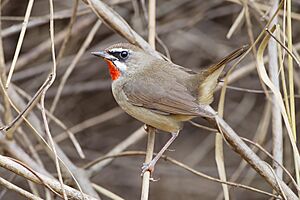Siberian rubythroat facts for kids
Quick facts for kids Siberian rubythroat |
|
|---|---|
 |
|
| Male | |
 |
|
| Female | |
| Conservation status | |
| Scientific classification | |
| Genus: |
Calliope
|
| Species: |
calliope
|
 |
|
Summer Winter |
|
| Synonyms | |
|
Luscinia calliope |
|
The Siberian rubythroat (Calliope calliope) is a small bird known for its bright red throat. It belongs to a group of birds called passerines, which are often called "perching birds." A scientist named Peter Simon Pallas first described this bird in 1776.
This bird used to be considered part of the thrush family. However, scientists now mostly agree it belongs to the Old World flycatcher family. Birds like the Siberian rubythroat are sometimes called "chats."
Contents
About the Siberian Rubythroat
The Siberian rubythroat is a bit bigger than the European robin. It has a plain brown back and a special black tail with red patches on the sides. A clear white stripe runs above its eye.
Male and Female Birds
Male Siberian rubythroats are easy to spot. They have a bright red throat. This red patch is outlined with a thin black line, then a wider white border. Female birds do not have this colorful throat.
Bird Song
The male Siberian rubythroat has a song that sounds a bit like a stronger version of the garden warbler's song.
Where Siberian Rubythroats Live
The Siberian rubythroat is a migratory bird. This means it travels long distances between its summer and winter homes.
Summer Homes
During the summer, these birds live and breed in Siberia. They prefer mixed coniferous forests that have lots of plants and bushes close to the ground. They build their nests near the ground.
Winter Homes
When winter comes, Siberian rubythroats fly south. They spend the colder months in warmer places like Thailand, India, Indonesia, and Bangladesh. You can see their wintering areas on the map.
Rare Sightings
Sometimes, a Siberian rubythroat might fly off course. They are very rarely seen in Western Europe, including Britain. They are also very rare visitors to the Aleutian Islands, especially Attu Island.
Siberian Rubythroat Family Tree
The Siberian rubythroat was once placed in a different bird group called Luscinia. Scientists study the genes of animals to understand how they are related. A big study in 2010 showed that the Luscinia group was not organized correctly.
Because of this, the group was split up. The Siberian rubythroat, along with other species, was moved to a new group called Calliope. The name Calliope comes from ancient Greek. It means "beautiful-voiced." In Greek mythology, Calliope was one of the muses, who were goddesses of arts and sciences. She was known for her eloquence and heroic poetry.
Gallery




